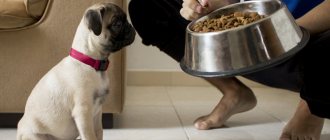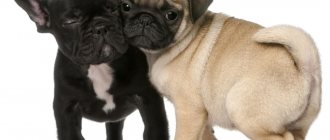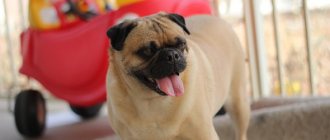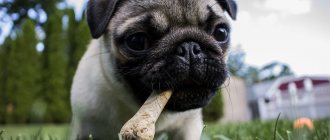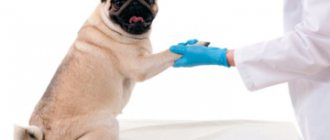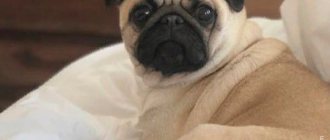02/06/2019 Drozd Nikolaevich Animals
There are different dogs. Big and small, serious and funny. And some are absolutely wonderful. Small plush creatures that are distinguished by a great mood, cheerful disposition and inexhaustible energy. Today we will talk about pugs. The history of the origin of the breed and some of the characteristics of these dogs will help you make the right choice and find a pet that is truly yours in spirit.
Ancestors of pugs
As has already become clear, the breed originated in China and gained great popularity at the court of the emperor, and then throughout the nobility. They are also mentioned in the treatises of Confucius. He described small, flat-faced dogs that were created around 400 BC. e. There are surviving images of animals wearing collars with bells. The history of the pug breed has experienced peaks of glory and oblivion, like many others.
As far as one can judge, its unprecedented popularity dates back to the 17th century. At this time, images of the ancestors of modern pugs appear on engravings and figurines, many of which have survived to this day. In those days, dogs did not yet have such deep wrinkles as modern dogs. But the drawing was already clearly visible. Experts believe that from the 16th century they can be considered fully developed dogs, although the history of the pug breed begins long before that.
Around the 16th - 17th centuries, these pets became favorites of women from high society. It was considered good form to keep this creature at home with a cute face that resembles an exotic monkey and sets off the beauty of the owner. They warmed the owner in her chambers, so they were called boudoir dogs.
Spread around the world
Despite all the data that has been collected to date, we still know very little about the origins of these animals. The history of the Pug breed goes back too far into centuries to answer all the questions. They are similar to the Pekingese. But here everything is obvious: both of them lived at the imperial palace.
We need to stop here, because the question is very interesting. Initially, it was believed that the pug was the first to be selected, and only then, as a result of crossing with long-haired canines, the Pekingese appeared. But recent research shows that the Pekingese is an ancient breed that traces its origins to Tibetan dogs that were originally brought to China. Genetic studies also confirm that this breed is older than the pug. That is, most likely, he was bred from the line of the shortest-haired Pekingese or was obtained by crossing them with other short-haired dogs.
Presumably they appeared three thousand years ago. Pugs lived in wealthy families and followed their owners everywhere. They were first brought to France in 1553 as a gift to local aristocrats. It was from here that they began to spread throughout Western Europe, and then throughout the world. The cute pug has repeatedly inspired artists and sculptors to create masterpieces. They came to Russia already in the 20th century, around the 20s. Of course, they have taken root here too and now live in many families.
Pugs in world history
These dogs have been living next to humans for so long that many events in which they figured have accumulated. Stories about the pug dog breed can be listed endlessly, but we will try to limit ourselves to only the most interesting:
- Puppies were distributed only in the circles of the nobility. An ordinary person could not have such a dog. Soon they began to appear in large monasteries.
- Emperor Ling placed female pugs in the same important position as his wives. They could move around all the chambers, and they were fed with the best meat.
- Around 1250, Marco Polo, while traveling in the East, became one of the first Europeans to see pugs on display.
- A couple of centuries later they began to be delivered to Holland.
- There is a version that during the assassination attempt on the Dutch king, he was awakened by a devoted pug. The breed has since become the official dog of the House of Orange.
Pug Nutrition
You can't call a pug a picky dog; rather, he is prone to overeating. He will ask you for tasty morsels, stretching out his front paw, wiggling his fingers to convince him (a feature of the breed!), and you yourself won’t notice how many of these morsels you will give away to please your pet. Don't want your dog to look like a sausage? Then - meals three times a day in small portions, a balanced diet and no snacks.
When accustoming your puppy to feeding, you need to lightly push him towards the bowl with the mixture. He will lick his lips first and then perhaps start lapping. At the age of 3–4 weeks, puppies are given complementary foods 2 times a day, 4–5 weeks – 3 times, 5–7 weeks – 4 times.
Some dog breeders feed their puppies raw minced meat. However, this is not suitable food for them, since it does not cause active work of the stomach and intestines and is not completely absorbed.
At the age of 4–5 weeks, the puppies are transferred to dry food; at the age of 5–6 weeks, they are gradually taken away from their mother, leaving her with her only at night.
So, gradually the puppies stop needing mother's milk and learn to accept solid food.
Starting from the 5th week, puppies begin to be fed milk semolina porridge, and from the 6th week - oatmeal soup cooked in meat broth. The meat must be chopped.
After 6 weeks from birth, puppies begin to add vegetables to their food. You can give them finely chopped raw meat, fish fillet, cottage cheese, yogurt, raw eggs, grated carrots.
We advise you to read: Japanese Spitz Dog Breed
Dog breeders recommend using fish oil as a vitamin supplement. You should start with 3-5 drops daily. At the age of 3 months, puppies can be given 2-3 teaspoons of fish oil and 1-2 pinches of chopped fresh herbs. If a puppy has an upset stomach, fish oil is excluded from the diet.
Calcium glycerophosphate can be given to puppies as a mineral supplement. In the first 3 months of the animal’s life, feeding is given at 0.5 tablets; at 7–8 months of age, the dose of calcium glycerophosphate in the puppy’s diet should be increased to 5 tablets.
There are several basic rules that must be followed when feeding a puppy:
- You should not feed the puppy from your hand or spoon, as in the future the dog will refuse to eat from the bowl;
- the puppy must know its place in the house. You should not give him food at the table during lunch and in the kitchen at the moment when they are cooking;
- if a dog refuses the food offered to it, it is not recommended to replace it with another type of food, since the animal, having learned that it can get something more tasty, will subsequently refuse regular foods;
- You should not force-feed your dog if it refuses food. The reasons for this are often poor quality food or the presence of some disease in the puppy;
- You should not teach your puppy to catch thrown food in the air. Food must be placed in a bowl. In this case, it is necessary that the dog does not pick up anything that falls on the floor.
Further Adventures
This is the long and very interesting history of the pug breed. How its name came about is another interesting question that does not have a clear answer. It is believed that it is made up of two Latin words - pugnus and pugnaces. The first means “fist”, which quite plausibly describes the dog’s face.
The British made a significant contribution to the development of the breed, and also continued breeding work, which allowed the dog to acquire modern features. It still remained accessible only to the highest circles of Spain, Italy, and France. Many artists depicted these dogs on their canvases.
The history of the origin of pugs is replete with famous names. There are emperors, monks, kings and queens. Around 1736, these dogs became the secret symbol of the secret society of the Order of the Pug, which was headed by the Master of Masons. Of course, the dog became one of the most beloved among the European nobility.
Napoleon's wife and Queen Victoria of England were very fond of these charming animals. They took them to bed with them and enjoyed doing them in their free moments. It should be noted that almost until the end of the 18th century, dogs were somewhat different from those familiar to us. They were taller, thinner, with longer snouts.
But the story of the appearance of the pug breed in a modern format did not end there. In 1860, French and British troops took the Chinese city during the Opium Wars. Among the loot were pugs and Pekingese dogs with shortened legs and muzzles. They also went to their new homeland, where they continued crossing with existing English pugs. Before this, the color of the breed was yellowish or fawn. But from that moment on, purely black representatives appeared.
Public acceptance
Reactions to new breeds are always different. Some people admire her, while others, on the contrary, consider her a caricature. But the case of pugs is unique. There is not a single country where they do not find their most passionate admirers. The Pug was one of the first breeds to be recognized by the American Kennel Club. A little later, in 1918, the united kennel club also recognized it. Since that time, the popularity of the breed in America has only grown.
This also applies to other countries. One after another, all cynological associations recognized the breed. Breeding clubs opened within countries. This was another milestone in the history of the pug breed. Its origin is lost in the centuries, but even today these charming creatures captivate with their appearance and character.
It is widely believed that the main reason for their popularity is their compact size, which is acceptable for women, but also their masculine enough image that they are recognized by the stronger half of humanity.
Description of the breed
Incredibly warlike and pugnacious dogs with a very unusual appearance. The stocky body is covered with thick and smooth hair. Main colors: silver, fawn (apricot), black. Characteristic features: wrinkled short muzzle, curled tail, dark and bulging eyes.
- The pug's head is long, round, large, without depressions on the skull. Should not resemble the shape of an apple. The transition from forehead to muzzle is clearly marked. The muzzle is blunt, short, square. Wrinkles are well defined.
- The ears are small, thin and soft, “velvety”. There are two types of ears: “button” ears - the ears are laid forward, fit tightly to the skull, the ear openings are not visible. The “rose” ears have a crease in the middle part, they are slightly laid back, and somewhat open the inner part of the ear. The preferred shape is “buttons”.
- The eyes are dark, round, very large, with a meek and gentle expression. The eyes shine brightly, and when the dog is excited, they are full of fire.
- The pug's nose is short, not snub. The nose is black, the nostrils are well developed.
- A pug's bite is called an underbite, with the lower teeth slightly protruding beyond the upper teeth.
- The dog's body is short and square in shape.
- The chest is wide, the ribs are well sprung.
- The pug breed has a short back and is distinguished by a straight topline, which should be neither convex nor sunken.
- The pug's forelimbs are very strong, moderate in length, and straight. They are placed parallel to each other, located “well under the body.” The paws are not as round as a cat's, but not as long as a hare's. The toes are separated, the claws are black.
- The pug's hind limbs are of moderate length and very strong. Placed in parallel. The feet, like the forefeet, have well-spread toes, neither too elongated nor too rounded. The claws are black.
- The tail is set high, curled as tightly as possible, and rests on the hip. A double curl is desirable.
- The pug's coat is delicate, thin, smooth, short and shiny, pleasant to the touch. Should not be hard or fluffy.
The color of a pug can be silver, fawn, apricot or black. With light colors, the ears, mask on the face, markings on the cheekbones, a spot on the forehead (in the form of a fingerprint or diamond), as well as the dark line on the back of the dog should be as black as possible.
We advise you to read: Doberman Dog Breed
Today and always
For more than 2,500 years, these dogs have been bred as companions and perform excellent tasks assigned to them. The breed has a very large and constantly growing number of fans. However, recently there has been a tendency to cross them with other dogs, such as beagles. The resulting interesting creatures are known as puggles. While any inbreeding is a one-time litter that does not go further into reproduction, these are considered purebred dogs.
It should be noted that great popularity has a bad effect on the purity of the breed. Due to the demand for offspring, unscrupulous breeders create entire puppy mills without caring about the health of mothers and babies. The main thing is quantity. Of course, when choosing a future family member, it is better to get to know the breeder better.
Pug character
Pugs are excellent companions and “bells.” These dogs will keep you company both on a walk and while watching TV, and as soon as a stranger appears at the door or knocks, they will immediately let the owner know about it with their barking.
Pugs are intellectuals, they are naturally well-mannered and devoid of aggression. This is a generally strong and resilient dog, but too active games are not for it. Pugs have a tendency to spend time passively, but in order to avoid health problems it is necessary to accustom them to regular movement, train and load the dog. If you allow your pet to sleep a lot and lie down all the time, very soon he will develop obesity and a whole bunch of other diseases. It is also important to follow a diet and not spoil the animal with sweets and other foods harmful to the dog.
Pugs get along well with children, they never offend them, they are also tolerant of pets, you can often see a pug and a cat sleeping in an embrace.
The price for pugs starts from 14-15 thousand rubles. It matters where and for what purpose you buy a dog; pet-class animals are always cheaper than show-class dogs.

